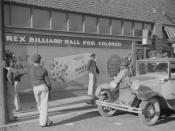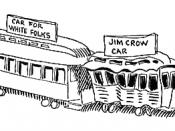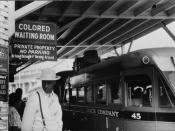Throughout time, Jim Crow has come to mean a vast amount of things. Segregation, primarily taking place in the Southern part of the U.S, came about after the Civil War. Segregation affected numerous people on a personal level. Jim Crow laws played an important role in the political and social lives of the South.
Over time, Jim Crow has come to mean a few different things. Jim Crow originally started as the name of a minstrel show character. The minstrel show most likely came from the imitation of blacks by white actors between acts of plays or during circuses. The main man in minstrel shows was Thomas Dartmouth Rice. Throughout the 1830's, Rice had many imitators. In 1842, the songwriter Daniel Decatur Emmett and three other men came up with a show of singing and dancing in blackface to bone castanets, the violin, the banjo, and the tambourine. They called themselves the Virginia Minstrels and made their first appearance in a New York City theater.
A different group called the Christy Minstrels began appearing a few years later and created many important features of the minstrel show. These included seating the performers in a half circle on the theater, with a tambourine player, often known as Mr. Tambo, at one end and a entertainer on the bone castanets, frequently called Mr. Bones, at the other end. During this, the performers would sing songs and exchange jokes. After the Civil War, minstrel shows became even more popular than before. The most famous of the minstrel composers was James Bland. After 1870, the popularity of the minstrel show declined quickly.
Jim Crow then became well known for the song "Jumpin Jim Crow" Between 1828 and 1831 Thomas D. Rice developed a song-and-dance routine. In it, he impersonated an old, crippled black...


